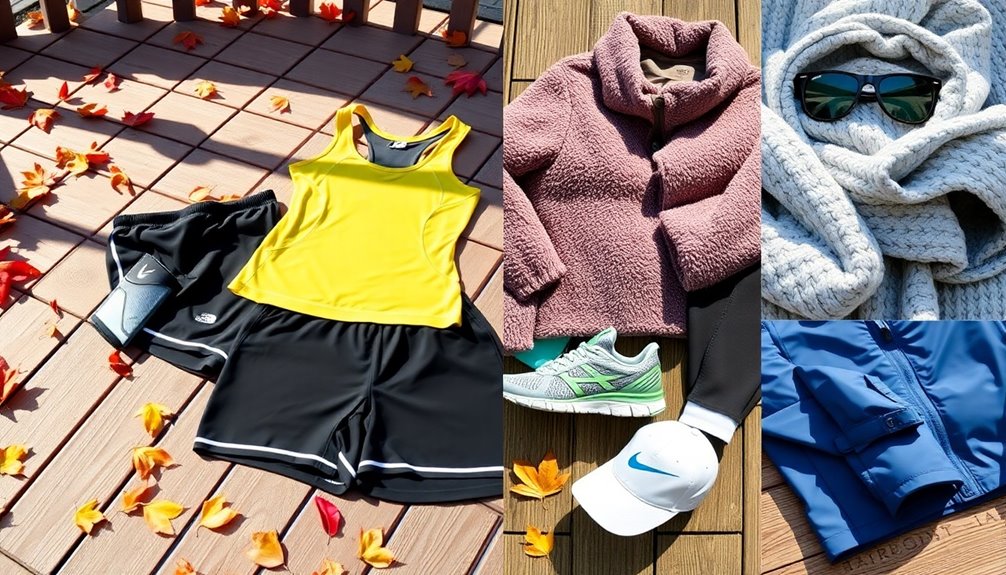To adapt your running routine for every season, layer up in winter and focus on traction for icy paths. In spring, embrace fluctuating temperatures, while summer demands hydration and lightweight clothing. Autumn is perfect for personal bests, but watch for slippery leaves. Equip yourself with the right gear year-round, adjust your nutrition according to seasonal needs, and incorporate mental strategies. There's plenty more to explore for making the most of your running journey, so keep going!
Key Takeaways
- Adjust clothing layers according to the season, using moisture-wicking and insulating materials in winter and lightweight fabrics in summer.
- Modify your running schedule to avoid extreme weather; run early in spring and summer to dodge heat and pollen.
- Incorporate seasonal nutrition by focusing on complex carbs in winter and hydration in summer to support energy levels.
- Stay safe with appropriate footwear and gear; use shoes with traction in winter and reflective clothing in autumn.
- Set seasonal goals and participate in local races to maintain motivation and track progress throughout the year.
Embracing Winter Running

When winter hits, you might feel tempted to hang up your running shoes, but embracing winter running can be invigorating.
Start by layering your clothing; wear moisture-wicking fabrics close to your skin to keep sweat away, add insulating layers, and finish with a windproof outer layer.
To stay safe, choose shoes with good traction and consider adding traction devices like microspikes for icy surfaces.
Before you head outside, warm up indoors with dynamic stretches or light exercises to prepare your muscles.
Don't forget to stay visible during those dark winter runs—reflective clothing and a headlamp can help.
Finally, remember hydration is essential; the cold can suppress your thirst, so drink water before, during, and after your runs. Additionally, consider how energy-efficient heating systems can help maintain a comfortable environment at home during the colder months.
Spring: A Time for Renewal

As winter fades and spring arrives, the running landscape changes dramatically, offering fresh opportunities for outdoor enthusiasts.
Layering is essential during this season due to fluctuating temperatures, so opt for moisture-wicking fabrics to stay comfortable on your runs. Don't forget a waterproof jacket for those unexpected spring showers!
Running early in the morning or after rain can help you avoid high pollen levels and manage allergy symptoms effectively. However, be cautious of slippery paths created by puddles, as they can cause blisters if you're not careful.
Spring is also the perfect time to gradually increase mileage and set seasonal fitness goals, giving you the motivation to track your progress and embrace the rejuvenating spirit of the season. Additionally, maintaining proper hydration and nutrition is crucial to support your body's performance as you ramp up your training.
Summer: Beat the Heat

Summer brings its own set of challenges for runners, and understanding how to beat the heat is essential for staying safe and enjoying your workouts.
Schedule your runs for early mornings or after sunset to avoid the hottest parts of the day. Wear lightweight, breathable clothing in light colors to reflect sunlight and keep cool.
Hydration is key—drink water before, during, and after your runs, and carry water bottles or plan routes near accessible water sources.
Don't forget sun protection; apply sunscreen, wear hats, and use sunglasses to shield yourself from UV rays. Sunscreen application is necessary to protect against UV damage while running outdoors.
Finally, adjust your running pace according to the heat; consider shorter, more frequent runs and take walk breaks if you start feeling dizzy or fatigued.
Autumn: Enjoying the Best Running Weather

Why not embrace the crisp air and vibrant colors of autumn for your running routine? The cooler temperatures and reduced humidity create perfect conditions for increasing your running distance and speed.
With moderate weather, now's the ideal time to set personal bests or participate in local races. Just remember, as daylight hours shorten, wearing bright or reflective clothing is essential for visibility during evening runs.
Also, be cautious of slippery fallen leaves, especially when wet, to avoid slips and falls.
To boost your performance and recovery, incorporate seasonal superfoods like root vegetables into your diet. Engaging in regular physical activities can enhance your overall fitness and endurance, making your runs even more enjoyable.
Enjoy this beautiful season while pushing your limits and reaping the rewards of your efforts!
Year-Round Gear Essentials

To keep your runs comfortable year-round, you need to choose the right gear for every season.
This means selecting footwear that suits various conditions, along with clothing that manages moisture and temperature effectively.
Don't forget essential accessories for safety, ensuring you're prepared for any weather or time of day. Additionally, investing in advanced filtration systems can help reduce allergens during outdoor runs.
Seasonal Clothing Choices
As the seasons change, your running wardrobe should adapt to guarantee comfort and safety throughout the year.
In winter, choose moisture-wicking layers to keep you dry and warm, effectively regulating your body temperature.
Spring calls for a lightweight jacket to shield you from sudden showers while remaining breathable.
During summer, opt for light-colored, loose-fitting clothing made from breathable fabrics to enhance airflow and reflect sunlight, helping you avoid heat exhaustion.
Autumn requires bright or reflective clothing for visibility during shorter days, reducing accident risks.
Throughout all seasons, equip yourself with versatile running shoes that offer traction and support, addressing seasonal challenges and ensuring you're prepared for varying terrain and weather conditions. Additionally, consider investing in waterproof running watches to track your performance in all weather conditions.
Footwear for All Conditions
- Traction: Choose shoes with specific tread patterns for different terrains—trail shoes for off-road and road shoes for pavement.
- Weather Protection: In wet conditions, opt for waterproof materials. For winter, look for shoes with insulated linings and consider traction devices like microspikes.
- Comfort: Summer shoes should be lightweight, breathable, and moisture-wicking to prevent overheating and blisters. Additionally, similar to selecting the right projector type for optimal performance, it's crucial to match your footwear to the specific running conditions.
Don't forget to regularly assess shoe wear and replace them every 300-500 miles to guarantee peak performance and injury prevention.
Your feet will thank you!
Essential Accessories for Safety
Maintaining a safe running routine goes hand in hand with choosing the right gear. Invest in reflective gear, like vests or armbands, to boost your visibility during those low-light winter and fall runs.
When the heat rises in summer or during wet spring conditions, moisture-wicking fabrics, especially in socks, will keep your feet dry and blister-free. A lightweight, waterproof jacket is essential for staying comfortable during unexpected showers or windy autumn days.
Don't forget a hydration pack or a handheld water bottle to guarantee you're well-hydrated during those long summer runs.
Finally, consider traction devices like microspikes for winter running to enhance your grip and overall safety on icy paths. Additionally, being aware of common causes of heat pump failure can help you choose gear that supports your running environment. Equip yourself wisely for all running conditions!
Staying Motivated Through Seasonal Changes

As the seasons shift, setting specific goals can keep your running routine fresh and focused. Joining a local running group can also help you stay motivated, providing support and accountability through any weather. Plus, embracing the beauty of each season makes your runs more enjoyable and energizing. Additionally, understanding the importance of setting clear boundaries can help you balance your running commitments with other aspects of your life.
Set Seasonal Goals
How can setting seasonal goals boost your running motivation? By establishing clear benchmarks, you can enhance motivation and keep your training plans focused. Here are three ways to do this:
- Increase Mileage: Aim for a 10% increase each spring as the weather improves.
- Participate in Seasonal Races: These events provide tangible goals that can elevate your running routine.
- Track Your Progress: Use a running app or journal to monitor improvements, celebrate achievements, and adjust your goals based on seasonal changes.
Incorporating variety into your routine, like exploring new routes in spring or focusing on speed work in winter, keeps things fresh and exciting. This ensures you're engaged and motivated all year round. Additionally, setting clear, achievable goals can help you stay focused and committed to your running journey.
Join Running Groups
Joining a running group can greatly enhance your motivation, especially when seasonal changes challenge your commitment. These groups offer a strong sense of community and accountability, helping you stay consistent even when the weather turns.
Many running groups adapt their schedules and routes to guarantee safe training, so you won't have to face challenging conditions alone. You'll also discover new training methods and challenges, like speed work or long-distance runs, which can boost your performance across seasons.
Plus, seasonal events like charity runs and themed races provide social and competitive opportunities, keeping your running experience enjoyable year-round.
Studies show that runners in groups stick to their routines 20% more consistently than solo runners, so consider joining today!
Embrace Nature's Changes
While the changing seasons can sometimes feel challenging, they also offer a fantastic opportunity to revitalize your running routine.
Here's how to embrace nature's changes:
- Set seasonal fitness goals: Aim to increase your mileage in spring or chase personal bests in fall races.
- Embrace the elements: Enjoy vibrant colors in autumn or fresh blooms in spring while running outside.
- Incorporate seasonal superfoods: Fuel your body with berries in spring and hydrating fruits in summer.
Take advantage of lower pollen times by running early or after rain, and consider joining local running groups for community and accountability.
Nutrition Adjustments for Seasonal Running

As the seasons change, so should your nutrition to support your running routine effectively. Here's how to adjust your diet throughout the year:
| Season | Nutrition Adjustments |
|---|---|
| Winter | Focus on complex carbohydrates and healthy fats for sustained energy. |
| Spring | Incorporate seasonal superfoods like berries for antioxidants and recovery. |
| Summer | Prioritize hydration with water and electrolyte drinks to combat fluid loss. |
| Autumn | Include root vegetables like sweet potatoes to support endurance training. |
Remember to adjust portion sizes based on your activity levels, as your caloric needs may increase, especially in winter due to higher energy expenditure. By making these nutrition adjustments, you can enhance your running performance year-round!
Mental Strategies for Year-Round Running

Adjusting your nutrition is just one part of maintaining a successful running routine throughout the year.
To stay motivated year-round, consider these mental strategies:
- Set achievable goals: Break down your year into smaller milestones to celebrate progress and boost motivation.
- Join running groups: Being part of a community fosters accountability and support, making it easier to stick to your routine.
- Embrace seasonal changes: Vary your routes and workouts to keep things fresh and engaging.
Incorporate mindfulness techniques during runs to enhance mental toughness and resilience, especially in tough weather. By focusing on your breath and maintaining present-moment awareness, you can better manage discomfort and fatigue. This holistic approach serves as an essential aspect of mental training for runners, as it equips you to face challenges with a calm and centered mindset. Additionally, visualizing your goals while running can further strengthen your resolve and keep you motivated, regardless of external conditions.
Keeping a running journal can also provide valuable insights, tracking your feelings and experiences to reinforce a positive mindset year-round.
Stay focused and enjoy the journey!
Incorporating Cross-Training

Incorporating cross-training into your running routine not only enhances your overall fitness but also helps prevent injuries. By engaging different muscle groups, cross-training activities like cycling, swimming, and strength training can boost your cardiovascular endurance and muscle strength. This contributes to better running performance while reducing the risk of burnout during tough weather or recovery periods.
| Cross-Training Activity | Benefits |
|---|---|
| Cycling | Improves endurance |
| Yoga | Enhances flexibility |
| Strength Training | Builds core strength |
A well-rounded program that includes cross-training increases running efficiency and speed. Remember, incorporating low-impact activities helps maintain proper running form, making injury prevention a priority.
Adapting to Daylight Changes

With the changing seasons, it's important to rethink your running schedule to stay safe and visible.
Here are three key adjustments to contemplate:
- Monitor sunset times: Check local sunset times and plan your runs accordingly to avoid unexpected darkness.
- Utilize reflective gear: Invest in reflective clothing and lights, especially during fall and winter, to enhance your visibility to drivers.
- Choose safe routes: Opt for well-lit routes and avoid isolated areas when running in low-light conditions.
Frequently Asked Questions
What Is the 80% Rule in Running?
The 80% rule in running means you should spend 80% of your weekly running time at a low intensity. This helps build endurance, allows for recovery, and reduces injury risk.
The remaining 20% is reserved for higher intensity workouts like tempo runs or intervals, which boost your speed and strength.
How to Structure a Running Season?
To structure your running season, visualize it like a tree with distinct branches: base building in winter, peak mileage in summer, and tapering in autumn.
You'll gradually increase intensity and volume, incorporating rest weeks to avoid burnout. Set specific goals, like a half marathon in spring, to keep you motivated.
Adjust your training for weather changes, and include cross-training in off-peak seasons to enhance your fitness and prevent injuries.
Does Your Body Adapt to Running Everyday?
Yes, your body can adapt to running every day, but it's essential to manage intensity and volume carefully.
As you run consistently, you'll notice improvements in muscular endurance and cardiovascular efficiency. Your muscles become better at storing glycogen, enhancing performance.
However, be sure to incorporate rest days and cross-training to prevent injuries and burnout. Gradually increasing your mileage by about 10% weekly will help maximize your adaptation while minimizing risks.
How Long Does It Take the Body to Adapt to Running?
When you start running, your body's like a sponge, soaking up new challenges.
In just 2 to 4 weeks, you'll notice improvements in your cardiovascular efficiency and muscle strength.
As you push through to 6 to 8 weeks, your endurance will soar, and you'll feel more capable than ever.
By 12 weeks, your muscles start transforming, becoming more efficient.
Keep varying your routine to maintain progress and avoid hitting a plateau!
Conclusion
No matter the season, running can be a joy when you adapt your routine. Think of your runs as a conversation with nature, where each season whispers its own secrets. Embrace the chill of winter, the blooms of spring, the heat of summer, and the crispness of autumn. With the right gear, nutrition, and mental strategies, you'll find that every run can be a rejuvenating escape. So, lace up your shoes and let each season inspire your journey!









